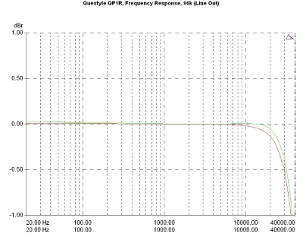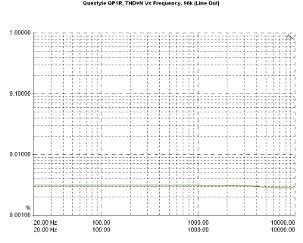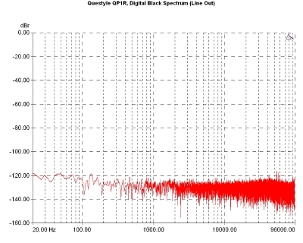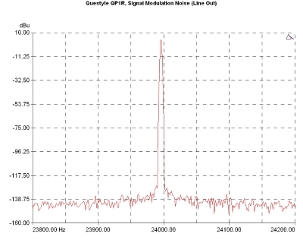about Audio, High Fidelity
& Home Entertainment technologies
pid: 607-2025/10/01 (v1.2)
Privacy Policy

QP1R's lab evaluation included playback of standard and high-resolution signals (16bit/44.1kHz and 24bit/96kHz). Both the line and the headphones output were used, the second while driving a pure resistive dummy load (32/600 Ohm). Signals, output and other relevant measurement conditions are described in the corresponding measurement comments.
The device showed some early signs of its quality during the first measurement, the very low-level signal playback, displayed in the time domain. The performance here was one of the best we have measured, at least for several years, and can only be compared directly with that of the Tascam DA-3000, a professional master recorder, which also relies on a solid-state memory for file playback (you can read its lab results in Greek language here). The relative waveform contains low levels of high-frequency noise and quite small traces of distortion in general, both indications of a very good behavior, indeed.
Frequency response (line out, 24/96 signal) is virtually flat without any deviation towards the low-frequency range and a mild -and quite expected- cut-off close to the 40kHz limit of the measurement. There is a little variation in the cut-off rate between the two channels, which however is only about 0.1dB and should not raise any concerns. In-band channel balance is exemplary.
Low-level signal playback (1kHz/-80dBFS, line out).
Frequency response (0dBr: 1kHz/-20dBFS, 24bit/96kHz, line out).
Output signal spectrum (headphones output, 16bit/44.1kHz sample rate) with a 1kHz signal, in “High” setting and with a 32-Ohm load, comprises a number of harmonics of which the stronger is the third. Harmonics reduction rate is quite high and, after the sixth, all are masked from the noise, below the -120dBr level. Overall, the whole distortion spectrum remained at very low levels.
Under the same gain setting but while driving a 600-Ohm load, QP1R's behavior is mostly identical except that the second harmonic is even more suppressed.
1kHz output spectrum, reference level: -20dBFS, 16bit/44.1kHz, 32 Ohm load.
1kHz output spectrum, reference level: -20dBFS, 16bit/44.1kHz, 600 Ohm load.
Overall, it appears that the QP1R is a device with low distortion and noise. The relevant graph remained in the region of 0.003% for the entire measurement range without any visible upward trend towards the higher frequency part of the spectrum.
Distortion's dependence on signal level (line out, 24bit/96kHz signal) was as expected, the distortion increasing as the signal decreased. However, even at -80dBFS level, distortion remained in the -20dB range, a performance that should be considered as very good -to say the least-, and confirms the observations of the time domain behavior, made at the first paragraph of this page.
Good performance in noise was confirmed by studying the noise spectrum (line out). There is no trace of hum components at 50/100Hz (mainly, a result of using a battery) and no high-frequency noise spikes up to the 96kHz measurement limit, a result that, probably, should be credited to the good mechanical assembly and the casing itself.
Finally, signal modulation noise is extremely low. The relevant graph does not include any serious, discrete modulation by-products from low-frequency signals. Traces of very low-frequency modulation can, however, be observed in the vicinity of the fundamental (24kHz), probably a result of some jitter introduced by the device. Nevertheless, the level is very low (below -120dBu) to be considered worthwhile.
Noise and interference spectrum (0dBr: 1kHz/-20dBFS, line out).
Signal modulation noise, reference signal: 23,995.50Hz, 24bit/96kHz, -5dBFS, line out.
Previous | Next | More Reviews









